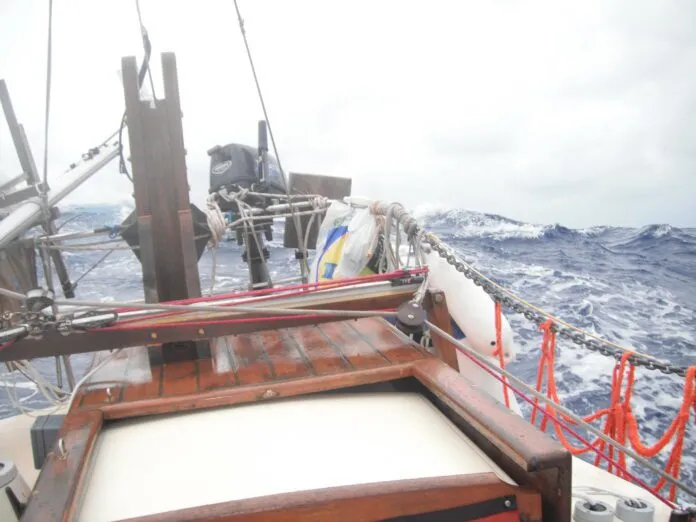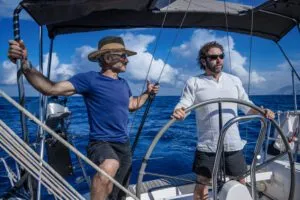
This article is not a “how to” on COB drills or other procedures. There is lots of good training available on that subject and anyway it is best to develop individual systems that suit your boat and crew. Staying on board in the first place should be your main objective. What I have not seen is much discussion on how to prepare yourself to cope when things get difficult so that you can stay calm at sea.
Over a rather long life I have worked as a sailing, climbing, caving and canoeing instructor as well as a first responder and with SAR teams. With that experience, I have seen lots of incidents and lots of ways people react in an emergency. Something I have learned is that the way you respond to an emergency is often at least as important as having the right equipment. No matter how well-equipped you are, the outcome frequently depends on how well the skipper and crew cope with an emergency.
I want to talk primarily about two ideas. First, how all of us react physiologically in an emergency and second a concept called “the incident pit.”
PHYSIOLOGICAL REACTIONS
When in a threatening situation, we all have a natural psychological and physiological reaction called the “fight or flight response.” This is an evolutionary trait developed to help us respond to things like attacks by wild animals. It is largely controlled by the release of hormones, adrenaline being the main one. But it also involves other hormones and reactions in your brain. What effect does this have? The fight or flight response aims to “sharpen us up” by increasing blood flow to the muscles, shutting down unnecessary systems like digestion and generally pushing us into a sort of physical overdrive.
While this may be very useful in a conflict with a bear, it can be counterproductive in the sort of situations we face as a skipper or crew. Why? The downside of the fight or flight response is that it primarily focuses on improving physical responses not intellectual ones. To some extent, adrenaline does sharpen our perceptions. You have probably heard of, if not experienced, what is described as “everything happening in slow motion” during an accident. This is an adrenaline reaction. The problem is that while physical responses and perception are heightened, logical and rational thinking is not! Often, particularly when the response tips into a panic state, rational thinking is more difficult, and in extremes breaks down completely. I have seen people break emergency gear or forget how to use it. I have also seen people make decisions that they afterward cannot understand.

“I don’t know why I did that, it made things worse,” or “I completely forgot about doing that,” are not uncommon things for people to think when looking back on an incident.
One of the techniques I learned on SAR training was to run flat out toward the scene of an accident until you are 100 meters from the casualty, then stop and walk the last bit while quietly taking some deep breaths. This was to counter the heightened state in yourself, and to calm and reassure the people you are coming to help. Someone who appears calm and controlled will make better decisions and encourage others who may be panicking to calm down.
THE INCIDENT PIT
The concept of the “incident pit” is very useful in preparing for emergencies. So, what is it? Basically, it describes how fast things can go wrong and why, because once one thing goes wrong, there is often a domino effect and more things go wrong. To understand the incident pit, consider an extreme. When a race car driver or a scuba diver has a problem, they only have seconds to deal with it. If the steering or brakes fail on the race car, the driver either deals with it instantly and gets control back, or the car runs off the track. If a scuba diver’s air regulator fails, they either get an alternate air supply immediately or blackout within about two minutes. These are extreme examples of a steep incident pit. The whole thing is over in seconds or maybe minutes.

Sailing, however, is generally the opposite. Very often we can see problems coming hours, or even days, in advance. This applies to things like storms. We see a weather forecast or the sky changing and know we have a problem heading our way—but we have time to prepare. Even in sudden emergencies, for example, a crew member getting injured or falling overboard, we may need a fast initial response but then will continue dealing with the incident for a long time. We could be engaged in a prolonged search or dealing with an injury until we get back to harbour. Because of this, sailing is characterized as having a long, slow incident pit.
What are the implications of this? The fight or flight response might prime us for fast action in a sudden emergency and speed up reactions in a way that could help the race car driver. When things happen in sailing however, we need clear thinking, good leadership and planning—none of which are enhanced by the fight-or-flight response. Rather, a high degree of initial stimulation can rapidly exhaust us and leave us less able to cope over the longer term. Plus, the adrenaline release can promote panic. All of this leaves us less capable of dealing with the next incident. Combine this with some bad weather and you can easily see why it is more likely that something else will go wrong.
This is the chief danger with long, slow incident pits. Each step down the incident pit reduces our ability to cope and increases the chances of something else going wrong! Eventually we reach a point where even a fairly minor event can be more than we can cope with.
WHAT YOU CAN DO
That describes the problem, but how do we improve our response to emergencies? How do we stop this slow, steady descent that can lead to a crew that is unable to cope? There are a number of things we can do and lessons we can learn from others. Think about a typical shift in a busy city emergency room. The staff do not go for a break between patients, and they will be dealing with possibly serious incidents one after another for the whole shift. Yet they are able to maintain a professional level of effectiveness right through, how do they do that? How do we, as skippers, get closer to that level?

The answer is personal preparation, practice and training. In other words, the ideal skipper, faced with an emergency, knows what to do, so they are confident they can deal with it. They have recently practiced the skills needed, with this crew, so they can put them into effect quickly. They know where any needed gear is, and that it all works because they have used it or tested it recently. Rather than sliding into the incident pit, this crew is able to deal with events quickly and efficiently, giving them time to recover.
I think you would agree that this describes how we would expect a professional skipper and crew to act. But how do we, as weekend skippers or regular amateur sailors, get closer this standard? In education, theory training is seen as the way to learn new skills, but you only develop expertise in using those skills through practice. Training and practice are seen as distinct stages in the learning process. The final step from being skilled at something to fully mastering it is when you can teach that skill to others. This is the key behind the ER team or the professional crew racing across the Southern Ocean. They practice skills until they become routine.
This is how a good skipper manages both the boat and the crew. They ensure people are well fed, rested and have the chance to practice and develop their skills. In the event of an emergency, they will then lead the crew in dealing with the situation effectively, and afterwards ensure people get debriefed and have a chance to recharge. Because the whole crew has practiced, this can be done as a team, with the skipper leading.

Without regular training, it is more likely that it will fall to the skipper to do most of the work while the crew gets stressed and panicky because they don’t know what to do. It is likely that more than one person will try to do some jobs while nobody does other equally important things. It may well be that each crew member has had training, but because they have not practiced as a team there is no coordination.
Often skippers put off practice because people are on holiday or they don’t want to appear tyrannical. Sometimes skippers put off training because they don’t want to frighten people and make it seem like sailing is dangerous. The answer to this is to do training in a “people-friendly” and fun way that makes it part of the enjoyment of sailing. Generally, crews will respond positively to the chance to practice skills, after all, it may be them overboard! Most people like to feel part of a team and get a lot out of being a highly skilled crew.
SOME TEST QUESTIONS
- When was the last time you unpacked the grab bag and checked the contents? Did you do it with the crew and ask them if they can think of anything else that should be in it?
- When was the last time you went through COB drills? Have you ever done a COB drill assuming it is the skipper overboard?
- When was the last time you checked the fire extinguishers or did a fire drill?
- When was the last time you did a steering failure drill and used the emergency tiller?

A good practice is to include one emergency drill on each passage. Also with regular crew, especially younger members, you can give them responsibility for some of the regular tasks. Designate someone to check the fire extinguisher every trip for example. For the youngsters make this part of being a responsible part of the crew and ensuring everyone’s safety is not just another “boat chore.”
REGULAR PRACTICE
Regular practice ensures that the crew knows what to do and checks all the gear is in place and working. Equally, or even more importantly, regular practice means that people feel confident that they can cope, it’s not just another drill, so when it happens “for real” they don’t become stressed. The fight or flight response is not triggered and you don’t burn up anywhere near as many physical or mental resources when coping with an emergency. That is how the team in the emergency room manages a busy full shift. It may be an emergency for the patient but for the staff it is a well-practiced response that is “all in a day’s work.” It is also how to avoid sliding into the incident pit. Because the initial event was dealt with efficiently and without drama it does not deplete the boat’s resources to the point where it becomes difficult to deal with the next incident and stress levels no longer reduce everyone’s decision-making skills.
For many of us, a big part of the appeal of sailing is the sense of self-reliance and independence but let’s make sure we are reliant on our skills and not dumb luck!


































